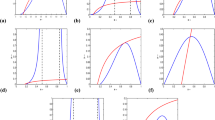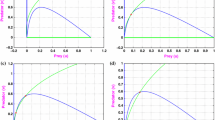Abstract
The contemporary study copes with a generalist predator–prey model with nonlinear cross-diffusion embracing prey refuge in proportion to both the species along with the ratio-dependent functional response. The investigation commences with the well-posedness keeping in view of the existence of all feasible non-negative equilibria together with their global dynamics for the corresponding temporal model. The refuge parameter plays a key role in the dynamics of the model in general and mediates the uniform persistence, the stability of the boundary and coexistent equilibria and even the Turing instability space, in particular. Another important observation is that refuge possessing a constant proportion predator–prey encounters leads to a weaker stabilizing effect than refuge possessing a constant proportion prey under certain system parameters. Subsequent exploration on three eminent classes of mechanism for Turing instability around the positive spatially homogeneous steady state reveals dynamical complexity stimulated by generalist predator of the model system. Some comparisons are given between refuge depending on prey and refuge depending on both the species. Finally, numerical simulations expose to view the growth of spatiotemporal patterns controlled by prey refuge together with both self- and cross-diffusion following the sequence of spots, stripe–spot mixtures, stripes, labyrinth, stripe–hole mixtures and holes as well. Thus the proposed model appears to be rich and complex from the dynamical point of view having novelty to contribute much to the system in the realm of ecology.

























Similar content being viewed by others
References
H. Amann, Dynamic theory of quasilinear parabolic systems III. Global existence. Math. Z. 202, 219–250 (1989)
H. Amann, Dynamic theory of quasilinear parabolic equations II. Reaction–diffusion systems. Differ. Integr. Equ. 3, 13–75 (1990)
R. Arditi, A.A. Berryman, The biological control paradox. Trends Ecol. Evol. 6, 32–43 (1991)
R. Arditi, L.R. Ginzburg, Coupling in predator–prey dynamics: ratio-dependence. J. Theor. Biol. 139, 311–326 (1980)
J.B. Collings, Bifurcation and stability analysis of a temperature-dependent mite predator-prey interaction model incorporating a prey refuge. Bull. Math. Biol. 57, 63–76 (1995)
C. Cosner, Variability, vagueness and comparison methods for ecological models. Bull. Math. Biol. 58, 207–246 (1996)
M. Cross, H. Greenside, Pattern Formation and Dynamics in Nonequilibrium Systems (Cambridge University Press, Cambridage, 2009)
G. Gambino, M. Lombardo, M. Sammartino, Pattern formation driven by cross-diffusion in a 2D domain. Nonlinear Anal. RWA 14, 1755–1779 (2013)
M.R. Garvie, Finite-difference schemes for reaction–diffusion equations modelling predator–prey interactions in MATLAB. Bull. Math. Biol. 69, 931–956 (2007)
E. González-Olivares, B. Gonzá-Yáñez, R. Becerra-Klix, et al., Multiple stable states in a model based on predator-induced defenses. Ecol. Complex. 32, 111–120 (2017)
E. González-Olivares, R. Ramos-Jiliberto, Dynamic consequences of prey refuges in a simple model system: more prey, fewer predators and enhanced stability. Ecol. Model. 166, 135–146 (2003)
E. González-Olivares, R. Ramos-Jiliberto, Comments to the effect of prey refuge in a simple predator–prey model. Ecol. Model. 232, 158–160 (2012)
L.N. Guin, S. Pal, S. Chakravarty, S. Djilali, pattern dynamics of a reaction–diffusion predator–prey system with both refuge and harvesting. Int. J. Biomath. (2021). https://doi.org/10.1142/S1793524520500849
L.N. Guin, S. Acharya, Dynamic behaviour of a reaction–diffusion predator–prey model with both refuge and harvesting. Nonlinear Dyn. 88, 1501–1533 (2017)
L.N. Guin, P.K. Mandal, Effect of prey refuge on spatiotemporal dynamics of reaction–diffusion system. Comput. Math. Appl. 68, 1325–1340 (2014)
R.J. Han, B.X. Dai, Spatiotemporal pattern formation and selection induced by nonlinear cross-diffusion in a toxic-phytoplankton–zooplankton model with Allee effect. Nonlinear Anal. Real World Appl. 45, 822–853 (2019)
R.J. Han, L.N. Guin, B.X. Dai, Cross-diffusion-driven pattern formation and selection in a modified Leslie–Gower predator–prey model with fear effect. J. Biol. Syst. 28, 1–38 (2020)
R.J. Han, L.N. Guin, B.X. Dai, Consequence of refuge and diffusion in a spatiotemporal predator–prey model. Nonlinear Anal. Real World Appl. 60, 103311 (2021)
I. Hanski, The functional response of predators: worries about scale. Trends Ecol. Evol. 6, 141–142 (1991)
M. Haque, Md. Rahman, E. Sabiar & Venturino, et al., Effect of a functional response-dependent prey refuge in a predator–prey model. Ecol. Complex. 20, 248–256 (2014)
J. Hardenberg Von, et al. Diversity of vegetation patterns and desertification. Phys. Rev. Lett. 87, Art. no 198101 (2001)
B.A. Hawkins, M.B. Thomas, M.E. Hochberg, Refuge theory and biological control. Science 262, 1429–1432 (1993)
S.B. Hsu, T.W. Hwang, Y. Kuang, Rich dynamics of a ratio-dependent one-prey two-predators model. J. Math. Biol. 43, 377–396 (2001)
L. Ji, C. Wu, Qualitative analysis of a predator–prey model with constant-rate prey harvesting incorporating a constant prey refuge. Nonlinear Anal. Real World Appl. 11, 2285–2295 (2010)
W. Ko, K. Ryu, Qualitative analysis of a predator–prey model with Holling type II functional response incorporating a prey refuge. J. Differ. Equ. 231, 534–550 (2006)
V. Krivan, Effects of optimal antipredator behavior of prey on predator–prey dynamics: the role of refuges. Theor. Popul. Biol. 53, 131–142 (1998)
O.A. Ladyzenskaja, V.A. Solonnikov, N.N. Ural’ceva, Linear and Quasi-linear Equations of Parabolic Type (Amererican Mathmathical Society, 1968)
D. Le, Cross diffusion systems on n dimensional spatial domains. Indiana Univ. Math. J. 51, 625–644 (2002)
G.M. Lieberman, Second Order Parabolic Differential Equations (World Scientific Publishing Co. Pte. Ltd., Singapore, 1996)
Y. Lv, R. Yuan, Y. Pei, Effect of harvesting, delay and diffusion in a generalist predator–prey model. Appl. Math. Comput. 226, 348–366 (2014)
A. Madzvamuse, H. Ndakwo, R. Barreira, Cross-diffusion-driven instability for reaction–diffusion systems: analysis and simulations. J. Math. Biol. 70, 709–743 (2015)
H. Malchow, Spatio-temporal pattern formation in nonlinear nonequilibrium plankton dynamics. Proc. R. Soc. B 251, 103–109 (1993)
J.N. McNair, The effects of refuges on predator–prey interactions: a reconsideration. Theor. Popul. Biol. 29, 38–63 (1986)
Md. Haque, S. Sarwardi Manarul, Dynamics of a harvested prey–predator model with prey refuge dependent on both species. Int. J. Bifurc. Chaos 28, 1–16 (2018)
L.D. Mech, Wolf-pack buffer zones as prey reservoirs. Science 198, 320–321 (1977)
H. Molla, Md. Rahman, S. Sabiar Sarwardi, Dynamics of a predator-prey model with Holling Type II functional response incorporating a prey refuge depending on both the species. Int. J. Nonlinear Sci. Numer. Simul. 20, 89–104 (2019)
J.D. Murray, Mathematical Biology I II (Springer, Heidelberg, 2002)
G.D. Ruxton, Short term refuge use and stability of predator–prey models. Theor. Popul. Biol. 47, 1–17 (1995)
D. Ryan, Robert S. Cantrell, Avoidance behavior in intraguild predation communities: a cross-diffusion model. Disc. Cont. Dyn. Syst. A 35, 1641–1663 (2015)
M. Sambath, K. Balachandran, L.N. Guin, Spatiotemporal patterns in a predator–prey model with cross-diffusion effect. Int. J. Bifurc. Chaos 28, Art. no 1830004 (2018)
S.J. Schreiber, Generalist and specialist predators that mediate permanence in ecological communities. J. Math. Biol. 36, 133–148 (1997)
N. Shigesada, K. Kawasaki, E. Teramoto, Spatial segregation of interaction species. J. Theor. Biol. 79, 83–99 (1979)
Y. Song, X. Tang, Stability, steady-state bifurcations, and Turing patterns in a predator–prey model with herd behavior and prey-taxis. Stud. Appl. Math. 139(3), 371–404 (2017)
G.Q. Sun et al., Spatial patterns of a predator–prey model with cross-diffusion. Nonlinear Dyn. 69, 1631–1638 (2012)
G.Q. Sun, Mathematical modeling of population dynamics with Allee effect. Nonlinear Dyn. 85, 1–12 (2016)
S. Wiggins, Introduction to Applied Nonlinear Dynamical Systems and Chaos, 2nd edn. (Springer, NewYork, 2003)
S. Wu, J. Wang, J. Shi, Dynamics and pattern formation of a diffusive predator–prey model with predator-taxis. Math. Models Methods Appl. Sci. 28, 2275–2312 (2018)
Acknowledgements
The first author (Dr. R.J. Han) acknowledges the foundation support from Youth Foundation of Zhejiang University of Science and Technology (Grant No. 2021QN001). The second and third authors are grateful to the Department of Mathematics, Visva-Bharati, Santiniketan, 731235, West Bengal, India for providing opportunities to carry out the present research work. The second author (Dr. L.N. Guin) gratefully acknowledges the financial support in part from Special Assistance Programme (SAP-III) sponsored by the University Grants Commission, New Delhi, India (Grant No. F.510/3/DRS-III/2015 (SAP-I)).
Author information
Authors and Affiliations
Corresponding author
Ethics declarations
Conflict of interest
The authors declare that they have no conflict of interest.
Appendix A: The proof of Lemma 3.2
Appendix A: The proof of Lemma 3.2
Proof
It follows from \(s_4<0\) that \(\delta -\gamma -\lambda <0\), which implies \(s_1<0\). Since \(s_0>0, s_1<0, s_4<0\), we get the total number of sign changes from one coefficient to the next in the sequence \(s_0, s_1, s_2, s_3, s_4\) is either equal to three or one. By \(Descartes'\,\,Rule\,\,of\,\,signs\), we obtain that the number of positive real roots of the polynomial Eq. (12) is either equal to one or three. Next we claim that Eq. (12) has only one positive real root under the assumptions \(s_3>0\) and \(s_1^2<\frac{8}{3}s_0s_2\). Since \(f^{\prime \prime }(x)=12s_0x^2+6s_1x+2s_2\), it follows that \(f^{\prime \prime }(x)>0\) according to \(s_0>0\) and \(\Delta :=36s_1^2-96s_0s_2<0\), which implies that \(f^\prime (x)\) is strictly monotone increasing in the interval \([0,\infty )\). Since \(f^\prime (0)=s_3>0\), we obtain \(f^\prime (x)>0\) in the interval \([0,\infty )\), which implies that f(x) is strictly monotone increasing in \([0,\infty )\). Hence Eq. (12) has only one positive root, and this completes the proof of part (i).
Finally, if \(s_2<0\) and \(s_3<0\) besides \(s_4<0\), then the total number of sign changes is equal to one, which implies that there is exactly one positive real root in Eq. (12). This proves (ii). Therefore the proof of the lemma is completed. \(\square \)
Rights and permissions
About this article
Cite this article
Han, R., Guin, L.N. & Acharya, S. Complex dynamics in a reaction-cross-diffusion model with refuge depending on predator–prey encounters. Eur. Phys. J. Plus 137, 134 (2022). https://doi.org/10.1140/epjp/s13360-022-02358-7
Received:
Accepted:
Published:
DOI: https://doi.org/10.1140/epjp/s13360-022-02358-7




